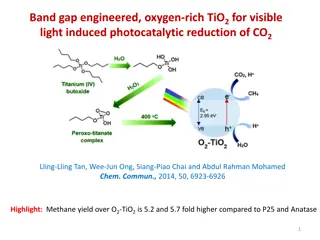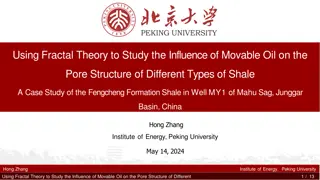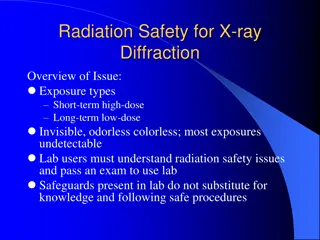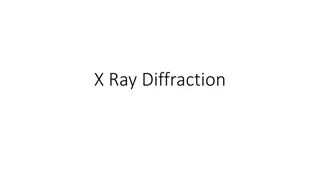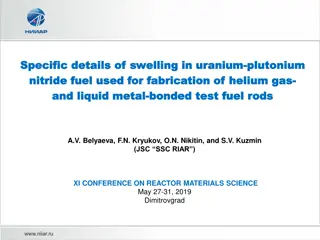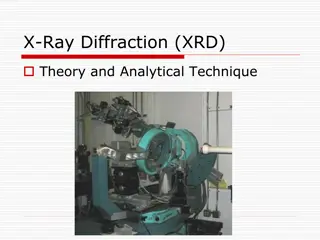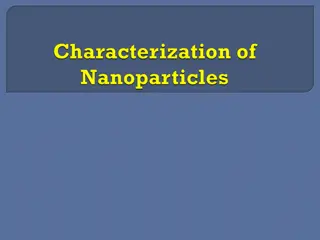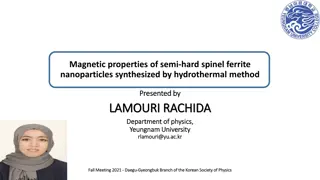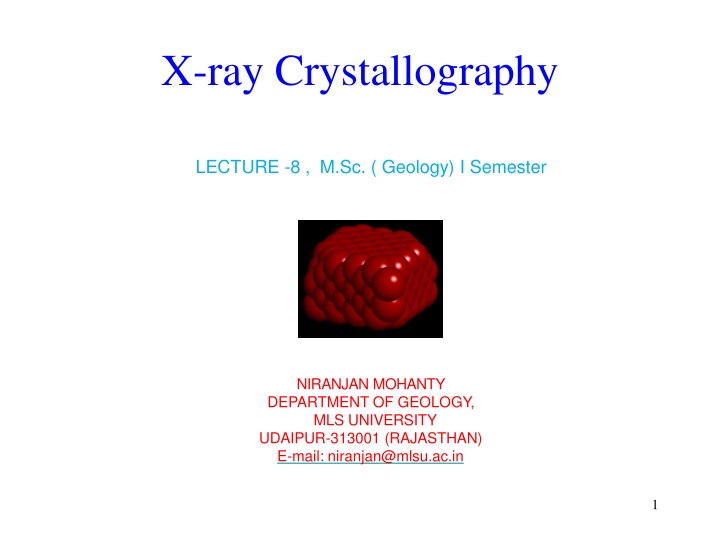
X-ray Crystallography in Geology: Discoveries and Applications
Explore the fascinating world of X-ray crystallography in geology, from the discovery of X-rays to the intricate details of electron transitions. Learn about the Einstein Equation, conversion to kinetic energy, white radiation effects, X-ray tubes, electron shells, copper spectra, absorption edges, scattering, and reflection conditions.
Download Presentation

Please find below an Image/Link to download the presentation.
The content on the website is provided AS IS for your information and personal use only. It may not be sold, licensed, or shared on other websites without obtaining consent from the author. If you encounter any issues during the download, it is possible that the publisher has removed the file from their server.
You are allowed to download the files provided on this website for personal or commercial use, subject to the condition that they are used lawfully. All files are the property of their respective owners.
The content on the website is provided AS IS for your information and personal use only. It may not be sold, licensed, or shared on other websites without obtaining consent from the author.
E N D
Presentation Transcript
X-ray Crystallography LECTURE -8 , M.Sc. ( Geology) I Semester NIRANJAN MOHANTY DEPARTMENT OF GEOLOGY, MLS UNIVERSITY UDAIPUR-313001 (RAJASTHAN) E-mail: niranjan@mlsu.ac.in 1
Discovery of X-rays Wilhelm Conrad Roentgen discovered x- radiation in 1895 In 1912, Friedrich, Knipping, and von Laue demonstrated diffraction of x-radiation passing through a crystal The wavelength of x-radiation ranges from 10-6 to 10-1 nm 2
Einstein Equation E = h = hc/ where E = energy h = Planck's constant = frequency c = speed of light = wavelength. 3
Conversion to Kinetic Energy If all the kinetic energy of an electron is converted to X-ray quanta, we can rewrite the equation as: eV = hc/ Replacing constants gives: (nm) = 1.24/kV Where kV = kilovolts 4
White Radiation Effect of excitation potential on minimum wavelength 5
X-ray Tube X-ray tube schematic diagram 6
Electron Shells Electron infall from outer to inner shells 7
Copper X-ray Spectrum 8
Copper Energy Levels Energy-level diagram for electron transitions in Cu 9
Copper X-ray Spectrum 10
Absorption Edge Absorption edge of Ni in relation to the emission spectrum of Cu 11
Scattering Scattering of X- rays by a row of equally spaced, identical atoms 12
Reflection Condition for reflection 13
Path Difference Path difference = 2d sin 14
Bragg Equation n = 2d sin where n is an integer d is the distance between successive parallel planes (the "interplanar" spacing) = glancing angle of incidence This is the condition for successful reinforcement of waves reflected off different layers 15
W.H. and W.L. Bragg Derived by English physicists Sir William Henry Bragg and his son Sir William Lawrence Bragg Shared Nobel Prize in Physics, 1915 16
Diffracted X-ray Cones Diffraction cones from a row of atoms 17
Cone Intersection Diffraction cones from three noncoplanar rows of scattering atoms, intersecting in a common line 18
Figure 12 Arrangement for a powder photograph 19
Powder Pattern Diagram showing the formation of lines from a powder 20
Laue Method a) Obtaining a Laue photograph with a stationary crystal b) Laue photograph of vesuvianite, taken along the A4 axis. Axial directions a1 and a2 were inked onto the photograph after development. 21
Laue Film Laue photograph, mineral unknown Named for its developer German physicist Max von Laue, who won the Nobel Prize in Physics in 1914 for the discovery of diffraction of X-rays by crystals 22
Weissenberg Rotation Method Austrian physicist Karl Weissenberg developed a rotating-crystal method which also translated the film, allowing unambigious index of each refraction 23
Precession Camera Buerger precession camera 24
Martin Julian Buerger American Crystallographer who developed the precession camera Crystal and the film move Film shows an undistorted replica of the corresponding reciprocal lattice plane Each diffraction may be indexed 25
Precession Film of Wavellite A precession photograph is quickly indexed since it shows very clearly the symmetry content of the reciprocal lattice Indeed the distance between the spots on the film is simply the reciprocal lattice distance between two nodes, scaled by the X- ray wavelength and the camera radius 26
Four Circle Diffractometer A crystal is randomly set on the goniometric mount Computer will measure and calculate the exact value that each of four angles has in order to observe the reflections of a specific set of planes (hkl) 27
Mounting Methods for Powders Placed in fine capillary tube of 0.2mm bore Coated on a fine glass fiber - the fiber is dipped in a liquid such as alcohol and then rolled in the powder Mixed with gum arabic and rolled between slips of glass into a fine spindle or a tiny ball, no more then 0.3 mm in diameter Sprinkled on a piece of tape mounted over a hole drilled in a circular piece of metal 28
Powder Method Advantages Fast - an analysis is completed in two hours or less Requires very small sample amounts, which is especially important in cases where the material is rare Sample preparation times are usually small The cost per analysis is low, although there is an initial investment in the X-ray equipment and associated computer 29

